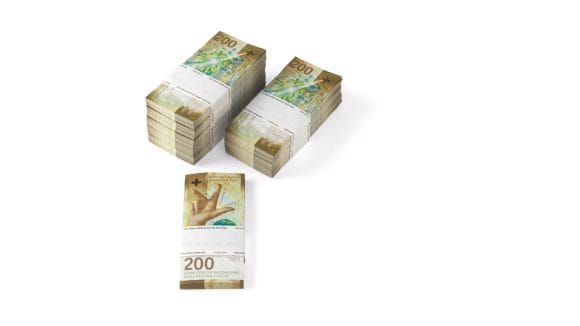We’re here for you
Arrange an appointment for a non-binding consultation or if you have any questions, just give us a call.

![]()
header.search.error
New banknote series
The new 200-franc note will go into circulation on August 22. Here are a few facts about Switzerland's second largest banknote.

The new 200-franc note, which is mainly brown in color, is more compact than its predecessor. It measures 70 x 151 mm compared to the previous 74 x 170 mm, and depicts author Charles Ferdinand Ramuz.
A 200-franc note was issued by the Swiss National Bank for the first time on October 1, 1997 as part of its eighth banknote series, replacing the 500-franc note. The second series of notes, which was launched in 1911 and replaced in 1956/57, even included a 40-franc and a 5-franc note.
Almost 56 million 200-franc notes were in circulation in 2017, which corresponds to 12.4% of all banknotes. This puts the second largest note in fifth place when it comes to the number of notes in circulation, just behind the 50-franc note, which represents 12.9%. The 100-franc note leads the way with 27.9%, while the 1000-franc note is bottom of the list with 10.5%.
Switzerland's total banknote circulation was worth 76.5 billion francs in 2017. The 200-franc note represents 14.6% of this sum, in third position after the 1000-franc and 100-franc notes, which represent 61.8% and 16.4% respectively.
One of the questions which featured in the SNB's 2017 payment method survey on payment behavior and the use of cash by households in Switzerland aimed to discover which denominations consumers generally choose for their cash withdrawals. The 200-franc note came third and was cited by around 11% of respondents. The 100-franc note was ranked top with 52%.
66% of those questioned in the payment method survey stated that they had owned at least one 200-franc note at some point in the past few years. 70% of male survey participants answered yes to this question. The response rate was similarly high in the 35 to 54 years and 55 years and over age groups. The figure exceeded 70% among respondents with a monthly household income of at least 10,000 francs, and reached 80% for residents of Ticino.
While the 1000-franc note is the most popular note withdrawn over the counter by over 50% of those questioned, more than 60% prefer the 200-franc note when withdrawing cash at ATMs.
Over 75% use the 200-franc note to pay for purchases, mainly electric devices and furniture and fittings – whereas 1000-franc notes are especially popular when buying a car. More than 25% of respondents also indicated that they frequently use 200-franc notes when paying invoices at the post office counter – a response that was particularly common among older people.
The banknotes from the seventh series issued in 1976 were recalled on May 1, 2000. This means that they are now no longer recognized as an official means of payment. You nevertheless have until April 30, 2020 to exchange old notes at the Swiss National Bank for their full face value.
Arrange an appointment for a non-binding consultation or if you have any questions, just give us a call.
Disclaimer